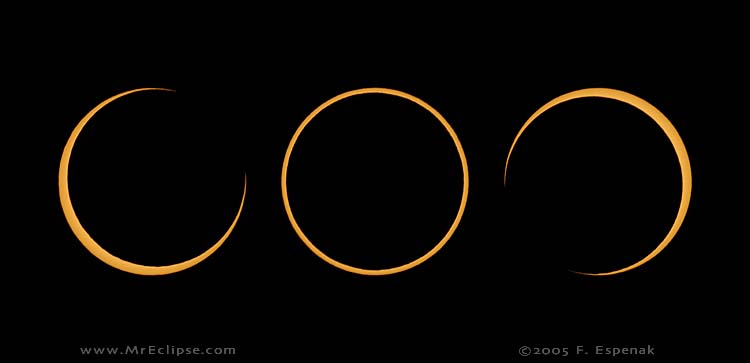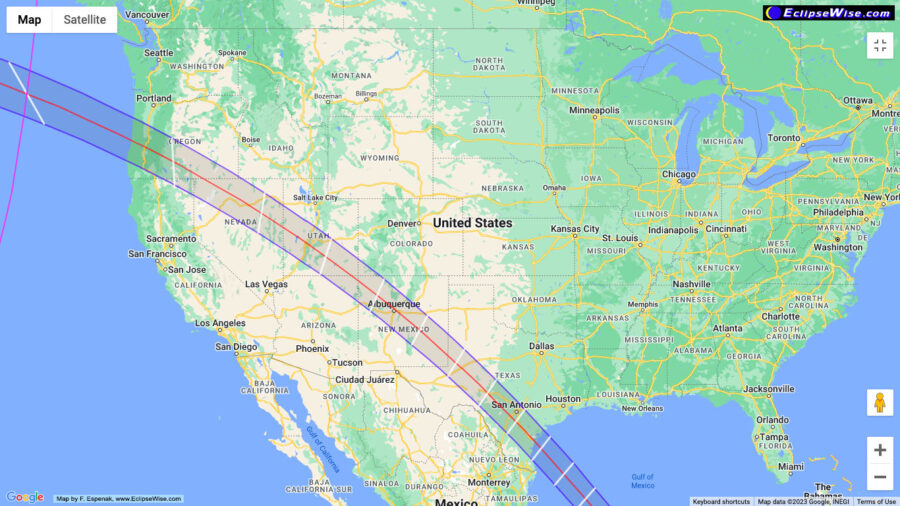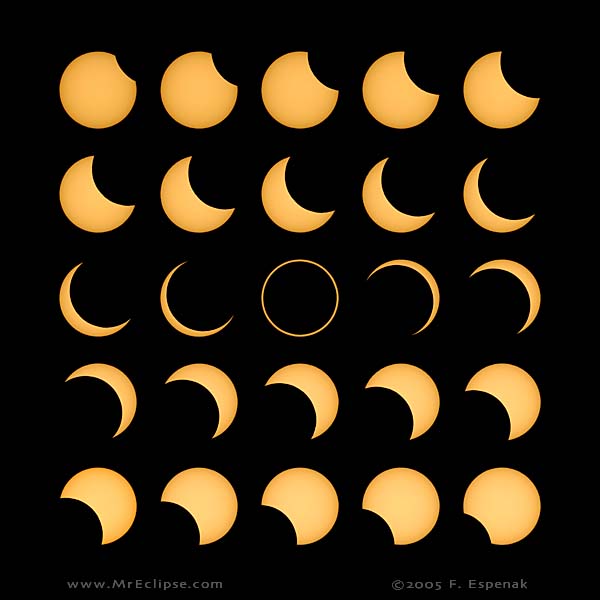If you’ll be in the path of the October 14, 2023, annular eclipse, here’s what you can look for as the Moon covers the face of the Sun.

© 2005 by Fred Espenak
Although annular eclipses of the Sun garner less attention than total eclipses, they are still fascinating astronomical events worth seeing. While they may not offer views of the solar corona or the eerie darkness of totality, they still showcase the “clockwork of the universe” as the Moon slowly covers and uncovers the Sun. Midway through, the symmetry of the black Moon completely silhouetted against the blazingly bright Sun is uniquely beautiful.
Where to See the Annular Eclipse
The following table gives the times for the phases of the eclipse in select U.S. cities within the path of annularity.
| Location | Partial phase begins | Annular phase begins | Partial phase ends | Duration of annularity |
| Eugene, Oregon | 8:05 a.m. | 9:17 a.m. | 10:40 a.m. | 3m 48s |
| Elko, Nevada | 8:07 a.m. | 9:22 a.m. | 10:50 a.m. | 4m 18s |
| Bryce, Utah | 9:09 a.m. | 10:28 a.m. | 11:58 a.m. | 2m 53s |
| Albuquerque, New Mexico | 9:13 a.m. | 10:34 a.m. | 12:09 p.m. | 4m 50s |
| Roswell, New Mexico | 9:16 a.m. | 10:39 a.m. | 12:15 p.m. | 4m 41s |
| Midland, Texas | 10:18 a.m. | 11:43 a.m. | 1:22 p.m. | 4m 55s |
| San Antonio, Texas | 10:24 a.m. | 11:52 a.m. | 1:33 p.m. | 4m 24s |
| Corpus Christi, Texas | 10:26 a.m. | 11:56 a.m. | 1:38 p.m. | 5m 02s |
The following table gives the times for the phases of the partial eclipse (outside the path of annularity) for select cities in the U.S. and Canada.
| Location | Partial phase begins | Maximum eclipse | Partial phase ends | Eclipse obscuration |
| Salem, Oregon | 8:06 a.m. | 9:19 a.m. | 10:40 a.m. | 88% |
| Seattle, Washington | 8:08 a.m. | 9:20 a.m. | 10:40 a.m. | 80% |
| Los Angeles, California | 8:08 a.m. | 9:25 a.m. | 10:50 a.m. | 71% |
| Las Vegas, Nevada | 8:08 a.m. | 9:27 a.m. | 10:54 a.m. | 82% |
| Vancouver, British Columbia | 8:09 a.m. | 9:20 a.m. | 10:38 a.m. | 76% |
| Salt Lake City, Utah | 9:09 a.m. | 10:28 a.m. | 11:55 a.m. | 87% |
| Calgary, Alberta | 9:14 a.m. | 10:27 a.m. | 11:45 a.m. | 61% |
| Denver, Colorado | 9:14 a.m. | 10:36 a.m. | 12:06 p.m. | 79% |
| Austin, Texas | 10:24 a.m. | 11:54 a.m. | 1:33 p.m. | 89% |
| Kansas City, Missouri | 10:25 a.m. | 11:50 a.m. | 1:21 p.m. | 61% |
| Winnipeg, Manitoba | 10:29 a.m. | 11:42 a.m. | 1:00 p.m. | 42% |
| Chicago, Illinois | 10:37 a.m. | 11:58 a.m. | 1:23 p.m. | 43% |
| Atlanta, Georgia | 11:43 a.m. | 1:12 p.m. | 2:45 p.m. | 52% |
| Toronto, Ontario | 11:56 a.m. | 1:10 p.m. | 2:25 p.m. | 27% |
| New York, New York | 12:09 p.m. | 1:22 p.m. | 2:36 p.m. | 23% |
| Montreal, Quebec | 12:12 p.m. | 1:18 p.m. | 2:24 p.m. | 17% |
| Boston, Massachusetts | 12:18 p.m. | 1:26 p.m. | 2:34 p.m. | 17% |
The path of October’s annular eclipse crosses parts of nine states: Oregon, California, Idaho, Nevada, Utah, Colorado, Arizona, New Mexico, and Texas. October usually offers pleasant temperatures and very good chances of clear weather in this part of the country. The largest cities in the path though the U.S. include Eugene, Oregon (pop. 177,000), Santa Fe, New Mexico (pop. 89,000), Albuquerque, New Mexico (pop. 562,000), Midland, Texas (pop. 131,000), San Antonio, Texas (pop. 1,452,000), and Corpus Christi, Texas (pop. 317,000). Michael Zeiler (GreatAmericanEclipse.com) has pointed out that seven national parks and many state parks lie in the path, so this adds another attraction for travel to the annular eclipse path.
Along the U.S. track, the average fraction of the Sun’s disk covered by the Moon during annularity is 89%. The remaining 11% is so blazingly bright that little hint of the eclipse will be apparent to the naked eye. Nineteenth-century astronomer Francis Baily described the darkness of annularity as “...being little more than might be caused by a temporary cloud passing over the Sun.”

Fred Espenak / Eclipsewise.com
To observe all phases of the eclipse, including annularity, suitable eye protection must be used. ISO-certified eclipse-viewing glasses are an inexpensive and convenient option. The American Astronomical Society (AAS) has a list of manufacturers for approved eclipse glasses. Pinhole projection is also a great way to view the eclipse. Telescopes, binoculars, and other optical instruments also require an approved solar filter.
Photographing the Annular Eclipse

© 2005 by Fred Espenak
It’s easy to photograph the eclipse using a telescope or a long telephoto lens. Either a digital single lens reflex camera (DSLR) or a mirrorless camera is best because it can accept a telephoto lens or be attached to a telescope with a suitable adapter.
The proper exposure can be determined either by using the camera’s built-in spot meter, or by using trial-and-error and inspecting the histogram of each exposure. The optimum exposure is one that peaks near the middle of the histogram. The same exposure can be used throughout the entire eclipse, so set the camera to manual exposure mode. If intermittent clouds pass across the Sun during the eclipse, you’ll need to adjust the exposure.
Obtaining a sharp focus is a common challenge for eclipse photographers. Fortunately, the Sun is becoming more active in the coming year and frequently has dark sunspots. These make focusing much easier. As the eclipse progresses, the crescent phases offer a good time to check focus using the sharp edges of the crescent horns.
To catch all aspects of the eclipse from start to finish, use your camera’s built-in interval timer (check your camera manual). An interval of one shot every five minutes (or even more frequently) will result in a very compelling time series that can be assembled into a mosaic image using a photo editing program like Adobe Photoshop. You might want to take more frequent shots during the 10 minutes surrounding annularity. If your camera does not have an interval timer, you can buy an inexpensive wired interval timer from Amazon or your favorite camera source. For more photo tips, see “How to Photograph an Annular Solar Eclipse.”
Baily’s Beads & Pinhole Crescents
One of the most interesting aspects of an annular eclipse is the appearance of Baily’s beads. These are beads of sunlight either disappearing or reappearing through deep lunar valleys along the limb of the Moon. You’ll need a telescope with a solar filter to resolve the beads in the seconds leading up to and immediately following the annular phase.
For locations near the central line of the path, Baily’s beads only appear for a few seconds. However, the grazing geometry near the inner limits of the annular path produce much longer displays of Baily’s beads, lasting tens of seconds at the expense of a shorter annular phase.
Use a mapping web page like the map here to choose a location near the inner edge of the path, where annularity lasts 20 to 40 seconds. Such locations will provide a grand display of Baily’s beads, especially inside the northern limit.

© 2005 by Fred Espenak
There is one more phenomenon not to be missed, and it doesn’t require a telescope. Look for small eclipse images on the ground under leafy trees or anything with a loose weave (straw hats, webbing of chairs). The small apertures or holes in these objects act like pinhole cameras that project images of the eclipse below them. You can even use a kitchen colander or perforated serving spoon to act as pinhole projectors. This effect is most prominent within 20 minutes of maximum eclipse.
Local times and annularity durations for a number of cities in the path of annularity through the U.S. can be found here. Of course, a partial eclipse will be visible from the rest of the U.S. and most of Canada.
For more on the eclipse, see "The Great Annular Eclipse of 2023" in the October issue of Sky & Telescope magazine.
Retired NASA astronomer Fred Espenak has traveled to 30 total and 11 annular eclipses of the Sun. He has written many books on eclipses including the 2023 annular and 2024 total solar eclipses. For more information, see EclipseWise.com.
 2
2









Comments
Andrew James
October 13, 2023 at 4:58 pm
Great story, but you've forgot to mention that the eclipse is passing through Central America and South America, going through Columbia and through the Amazon and onto the Atlantic coast of Brazil. This event will be in the afternoon. People living in the populated city of Cali in southern Columbia will see annularity, and they have made significant effort in educating the public there.
You must be logged in to post a comment.
Fred EspenakPost Author
October 13, 2023 at 5:38 pm
Andrew - Yes you are right that the path of annularity passes through Mexico, Central America, and South America. However, this brief blog post is targeted towards observers in the USA. There's so much to say that I could write a book on this eclipse, but a blog post must be brief and targeted. For more on this eclipse, please see: https://www.eclipsewise.com/solar/SEprime/2001-2100/SE2023Oct14Aprime.html
You must be logged in to post a comment.
You must be logged in to post a comment.